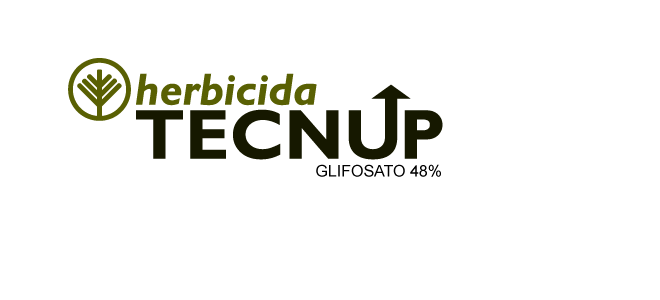

Composition:
| GLYCINE SALT | 48 % (p/v) |
| Inerts | 52 % (p/v) |
Remark: The salt acid equivalent is 36%
Chemical group:
GLYCINE DERIVATIVES.
Formulation:
SOLUBLE CONCENTRATE (SL).
Overview:
TECNUP is a post-emergent herbicide of rapid penetration without residual effect for control of grass weeds and annual, biannual and perennial broadleaves in cultivated and non-cultivated areas. TECNUP acts systematically, translocating itself through the sap conducting system of plants, killing them by inhibition of the essential amino acids.
Application method:
It can be applied in land pulverizations using back pulverizer, power-driven or tractor boom sprayers with the adequate spikes. Oils, moisturizers, surfactants can be added.
Phytotoxicity and compatibility:
Is compatible with most of the phytosanitary products of common use, except the ones of strong alkaline reaction. Always run prior tests of physical compatibility for mixtures with emulsifiable concentrates. Does not affect the crops due to the presence of phytotoxic residues in the soil. Drift mists can cause irreversible damage to nearby crops, mainly grasses (cereals, sugar cane, lawn, pastures).
Toxicological class:
Class IV – Green Stripe.
Antidote:
Does not possess.
Packing:
1- Boxes of 12 Containers of 1 L.
2- Boxes of 4 Container of 5 Lts.
3- Container of 20 Lts.
Remark:
In the case of difficult-to-control weeds such as BUVA (Conyza spp.), it can be mixed with 2,4D, according to the 3:1 proportion (Glyphosate: 2,4D), in 180 to 200 liters of liquid/Has (See 2,4D specifications). In case of presence of resistant Amargoso (Digitaria insularis): in desiccation it is used 3 liters of Glyphosate (Tecnup), with 0,75 to 1 liter mixed with Cletodym (Todym).
Directions for use:
Weeds:
Annual grasses smaller than 4 tillers and broadleaves with less than 12 leaves.
Dose: 2,0 – 2,5 l/ha
Weeds:
Annual grasses higher than 4 tillers and broadleaves with more than 12 leaves.
Dose: 2,5 – 4,0 l/ha
Weeds:
Underdeveloped perennial grasses
Dose: 3,0 – 4,0 l/ha
Weeds:
Developed perennial grasses.
Dose: 5,0 – 6,0 l/ha
Weeds:
Underdeveloped perennial broadleaves.
Dose: 5,0 – 7,0 l/ha
Weeds:
Developed perennial broadleaves and sedges.
Dose: 6,0 – 7,0 l/ha
Time of Application: “Underdeveloped” are the weeds smaller than 12 cm (average) and “developed” are those greater than 12 cm in height. It can be mixed with pre-emergent herbicides (check restrictions on the pre-emergent labels). For wheat it can be mixed with Metsulfuron or 2,4D for control of creepers and Santa Lucia weeds. For rice it can be mixed with 2,4D or Metsulfuron for control of sedges and broad leaves in general. For corn it can be mixed with 2,4D for general broadleaves control. For soybeans it can be mixed with chlorimuron (up to 80 g/ha) for control of creeper species or Zethapyr (for residual control of creeper and Santa Lucia weeds). For fast drying, apply Tecnoquat sequentially 5 days later. It can be mixed with “Supermyl or Clorfos” for control of early plagues and soil.
Weeds:
Annual grasses smaller than 4 tillers and broadleaves with less than 12 leaves.
Dose: 2,0 – 2,5 l/ha
Weeds:
Annual grasses higher than 4 tillers and broadleaves with more than 12 leaves.
Dose: 2,5 – 4,0 l/ha
Weeds:
Underdeveloped perennial grasses.
Dose: 3,0 – 4,0 l/ha
Weeds:
Developed perennial grasses.
Dose: 5,0 – 7,0 l/ha
Time of Application: “Underdeveloped” are the weeds smaller than 12 cm (average) and “developed” are those greater than 12 cm in height. It can be mixed with pre-emergent herbicides (check restrictions on the pre-emergent labels). For wheat it can be mixed with Metsulfuron or 2,4D for control of creepers and Santa Lucia weeds. For rice it can be mixed with 2,4D or Metsulfuron for control of sedges and broad leaves in general. For corn it can be mixed with 2,4D for general broadleaves control. For soybeans it can be mixed with chlorimuron (up to 80 g/ha) for control of creeper species or Zethapyr (for residual control of creeper and Santa Lucia weeds). For fast drying, apply Tecnoquat sequentially 5 days later. It can be mixed with “Supermyl or Clorfos” for control of early plagues and soil.
Starbur / Acanthospermum australe
Bristly starbur / Acanthospermum hispidum
Billy goat weed / Ageratum conyzoide
Green Amaranth / Amaranthus hybridus
Slender Amaranth / Amaranthus viridis
Bristle Oats / Avena strigosa
Cobbler’s Peg / Bidens pilosa
Marmelade grass / Brachiaria plantaginea
Southern Sandbur / Cenchrus echinatus
Asthma Weed / Chamaesyce hirta
Lamb’s quarter / Chenopodium album
Fragrant flatsedge / Cyperus ferax
Fierce Thorn Apple / Datura ferox
Crabgrass / Digitaria horizontalis
Barnyard Grass / Echinochloa crus-galli
Goosegrass / Eleusine indica
Red Tasselflower / Emilia sonchifolia
Wild Spurge / Euphorbia heterophylla
Gallant Soldier / Galinsoga parviflora
Hairy Indigo / Indigofera hirsuta
Common Morning Glory / Ipomoea aristolochiaefolia
Klip Daga / Leonotis nepetifolia
Siberian motherwort / Leonurus sibiricus
Bearded Ryegrass / Lolium multiflorum
False Mallow / Malvastrum coromandelianum
Wild Buckwheat / Polygonum convolvulus
Radish / Raphanus raphanistrum
White-eye / Richardia brasiliensis
Green Foxtail / Setaria spp
Heart-leaf Sida / Sida cordifolia
Arrow-leaf sida / Sida rhombifolia
Common Milk thistle / Sonchus oleraceus
Carb White / Alternanthera tenella
Palisade Grass / Brachiaria brizantha
Signal Grass / Brachiaria decumbens
Horseweed / Conyza bonariensis
Bermuda Grass / Cynodon dactilon
Purple nutsedge / Cyperus rotundus
Chufa Flatsedge / Cyperus esculentus
Sourgrass / Digitaria insularis
Guineagrass / Panicum maximum
Buffalo Grass / Paspalum conjugatum
Bahia Grass / Paspalum notatum
Russell-river Grass / Paspalum paniculatum
Common Knotgrass / Polygonum aviculare
Curly dock / Rumex crispus
Sugar Cane / Saccharum officinarum
Aleppo Grass / Sorgum halepense
Downloads
229 KB


